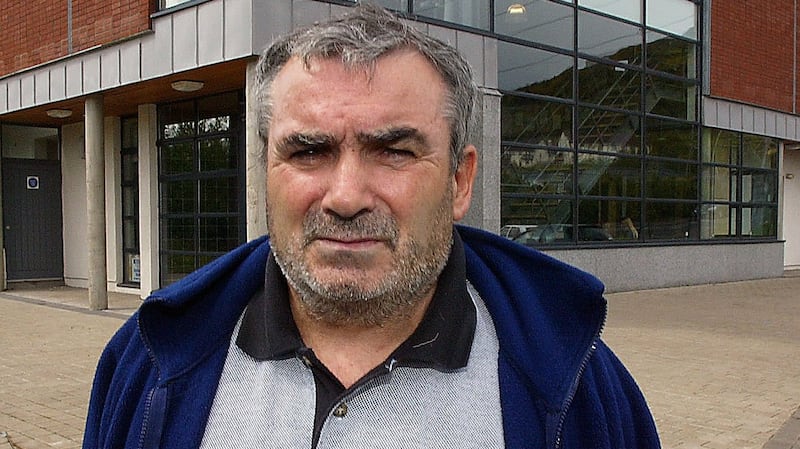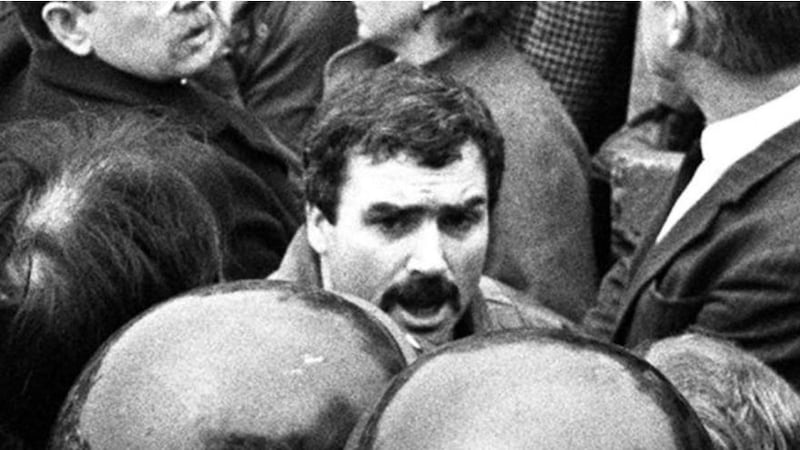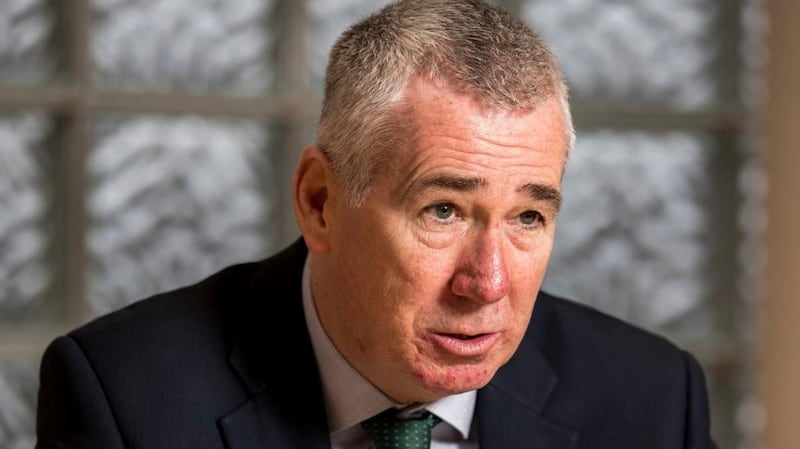Walking down the Glen Road in nationalist west Belfast a month after his release from prison on Valentine’s Day, 1986, Seamus Kearney made his mother a promise.
She told Kearney she had a job for him: she wanted him to find out what happened to his younger brother, Michael.
“I need you to find out if he was an informer,” she told her son.
Michael Kearney joined the Provisional IRA in 1978. Within a year, the 20-year-old was dead. In July 1979 he was killed and left on a roadside in Co Fermanagh. The IRA released a statement claiming he had been “executed” because he was an informer.
I said: ‘Who the hell’s he? Is he an ice-cream man?’ I was told that he was [IRA] internal security unit... That was the first time I heard his name. It was 1986
— Seamus Kearney on Freddie Scappaticci
“I told my mother I probably would have shot him myself if he was an informer. She wasn’t a republican but said she understood. She asked me to get the truth before she died,” says Seamus Kearney, a former IRA member who served almost 10 years of a 14-year sentence for the attempted killing of an Ulster Defence Regiment (UDR) soldier.
Beginning his search for answers about his brother’s final days, someone told him: “Michael was with Freddie Scappaticci.”
“I said: ‘Who the hell’s he? Is he an ice-cream man?’ I was told that he was [IRA] internal security unit... That was the first time I heard his name. It was 1986,” Kearney told The Irish Times.
Stakenife
The son of an Italian immigrant who ran an ice-cream van in the Markets area of Belfast, Freddie Scappaticci is at the centre of a £37 million (€43 million) independent investigation into his alleged role as the British military’s top IRA spy, Stakeknife.
He denied he was the high-ranking double agent right until his death four months ago at the age of 77.

With over 1,000 witness statements and more than one million pages of material gathered in the vast investigation, an interim report is expected to be released next month – seven years after former Bedfordshire chief constable Jon Boutcher agreed to oversee it.
Named Operation Kenova, it is also examining the role of the British state in multiple murders connected to Stakeknife.
It is thought Scappaticci was involved in up to 30 murders, including 18 where he directly carried out the killings; Michael Kearney’s abduction is among the first linked to the man known as “Scap”.
“My brother was interrogated by a British military officer... who was apparently the biggest British agent since the second World War. It adds a whole new layer,” said Seamus Kearney.
Ask former IRA members in Belfast about Scappaticci today and there is silence.
“It’s a taboo,” said one, “even with him dead.”
‘Complete denial’
As head of the Provisional IRA’s notorious internal security unit, known within the paramilitary organisation as the “nutting squad”, Scappaticci was responsible for identifying, kidnapping, and torturing informants or “touts” in the 1980s.
Many relatives of those interrogated are reluctant to speak.
“There is still a wall of silence,” said solicitor Kevin Winters, who represents 12 families who have co-operated with the Kenova investigation, including the Kearneys.
“That’s because it is deeply uncomfortable for the republican movement and for Sinn Féin. Twenty years ago, there was a complete denial by senior figures when Scappaticci was outed. The stigma of ‘the tout’ and ‘the family of the tout’ still runs very deep. Notwithstanding the fact this man was a British agent, there is the residual suspicion and concern about sticking your head above the parapet.”
Once described by a British Army general as the “golden egg” of British military intelligence during the three-decade Northern Ireland Troubles, Stakeknife was credited with saving “hundreds and hundreds of lives”.
Others see his role differently, as the IRA man responsible for investigating and killing informers was himself an informer and may have killed, and had others killed, to protect his own status as a double agent.

When he was named in the media in 2003, Scappaticci fled to England. Following the news coverage, he gave a press conference denying he was Stakeknife but left his west Belfast home weeks later. He lived under an assumed identity until his death.
If Scappaticci was so senior, how come the IRA was able to carry out all the operations it was able to carry out at the time?
— Danny Morrison
“He betrayed his comrades, he betrayed his community. He was despised,” Danny Morrison, former Sinn Féin director of publicity, told The Irish Times. “There was no sympathy for him.”
‘Stupid Paddys’
In 1990, Morrison was sentenced to eight years in prison in relation to kidnap and conspiracy to murder IRA informer Sandy Lynch. That conviction was quashed by a Court of Appeal in 2008, though the State withheld its reasons for doing so.
Morrison says Scappaticci was responsible for his arrest in 1990 – it was after this he was “stood down”, according to Morrison – but believes accounts of his seniority as an informer have been “exaggerated”.
“If Scappaticci was so senior, how come the IRA was able to carry out all the operations it was able to carry out at the time? People who assume the IRA was so infiltrated that it was forced into a peace process – it’s so racist in a way as it’s assuming they’re all ‘stupid Paddys’,” he said.
“Scappaticci was a paid agent, and, according to many accounts, had the power to get people killed who the IRA had suspected were informers. Regardless of my total opposition to British rule in Ireland, from a military intelligence point of view, presumably if someone’s working for you, you have a duty of care towards them,” said Morrison.
“Instead, what they did, once a low-level agent had outlived his usefulness, they allowed Scappaticci to have that person killed in order to increase the prestige of Freddie Scappaticci as a spy-catcher. They knew that if someone is killed by the IRA inside the nationalist community, it is demoralising, it loses the IRA support among cousins, friends, family of that person. That was their strategy.”

The Kenova report is undergoing security checks but there are doubts over whether it will result in prosecutions.
Publication will coincide with the expected passing of the UK government’s controversial legacy bill into law, which will effectively provide a conditional amnesty for those involved in Troubles-related crimes.
Personally, I think the report will be a fudge. It’s too bloody ugly. I don’t think the British government will want people to see their real role in the conflict
— Seamus Kearney on the Kenova report
Confirming Scappaticci’s death in April, Boutcher insisted that his team “remain committed to providing families with the truth of what happened to their loved ones and continue to actively pursue criminal charges against several individuals”. Extensive files have been submitted to Northern Ireland’s Public Prosecution Service (PPS) since 2019.
“We also recognise that people may now feel more able to talk to the Kenova team following the death of Mr Scappaticci, who had long been accused by many of being involved in the kidnap, murder and torture of potential PIRA informants during The Troubles,” Boutcher said at the time, while issuing a further appeal for those with information to come forward.

‘So many obstacles’
Seamus Kearney is among the relatives of victims who have spoken to Boutcher and his team. They first met in 2016.
“Jon Boutcher is well-intentioned. I have confidence he will try and get to the bottom of it. He wants to do the best but he has so many obstacles in his way,” says Kearney.
“Personally, I think the report will be a fudge. It’s too bloody ugly. I don’t think the British government will want people to see their real role in the conflict. It was agents of the State who killed my brother. I don’t think there will be any prosecutions.”
In an unprecedented move, Michael Kearney’s name was “cleared” in 2003 following an internal IRA investigation sparked by Seamus Kearney’s quest for the truth.
“The army [IRA] read out its report to me in the kitchen of a west Belfast house saying he wasn’t an informer,” Kearney says.
It transpired that Michael Kearney was taken to Castlereagh Holding Centre in June 1979 and “broke” after three days, telling the Royal Ulster Constabulary (RUC) where a small quantity of explosives were stashed.
They released him but didn’t charge him, which “put a target on him”, his brother said. He was subsequently “lifted” by Scappaticci and the IRA’s internal security unit, who drove him to a house in Dundalk where he was interrogated for 16 days. He was then taken to a remote border area and shot dead.
Almost 20 years after making his promise to his mother Kathleen, Seamus Kearney went to see her at her home in Downpatrick and gave her the IRA report.
‘Good name restored’
“She asked where the apology was. I told her: ‘That is the best we’re going to get. They’re clearing his name.’
“She was relieved but said it didn’t bring Michael back. I remember her saying: ‘I now can go to my grave knowing my son’s honour and good name have been restored,’” Kearney recalled.
“We had a commemoration Mass for him in June 2003. There were over 1,000 people at it. People were told not to go to original funeral in 1979.”
His mother died in 2010.
Kearney, who has published a book, No Greater Love, about his life in the IRA and losing his younger brother, becomes emotional recalling his last conversation with his brother.
It was March 1979 and Seamus had been “on the blanket” – a protest when the IRA refused to wear prison uniform – in the Maze/Long Kesh prison for two years; someone had told him his younger brother had joined the IRA. He requested that Michael visit him in the prison on his own.
“I told him: ‘Get out of it [the IRA].’ He said: ‘I can’t, I have to help you.’”
Seamus told his brother that the only way he could help was by focusing on his apprenticeship as an electrician and looking after their mother until he got out of prison.
‘Wits’ end’
“I told him he would end up in prison or dead. I was at my wits’ end,” he said.
“The last words he said to me were: ‘Will you give me your blessing?’ I told him it would end in tears. I was trying to save his life. I was the older brother. He wouldn’t listen.”
When the 30-minute visit was up, Kearney started walking back to his cell. He looked back and his brother turned back at the same time, each man catching the other’s gaze.
“He nodded and I nodded,” said Kearney, “and that was it.”











